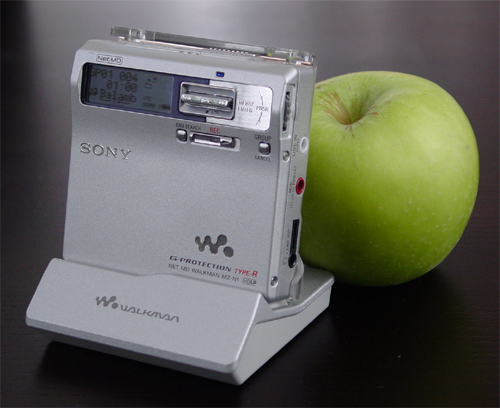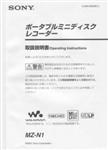|
|
The MiniDisc format reaches a milestone
|
|
|
Review Date:
|
January 1, 2002
(Last Updated: Jan 14, 2002)
|
Review Unit
purchased from:
|
Japan-Direct
www.japan-direct.com
|
|
Model:
|
MZ-N1 (Japanese model)
|
|
Dimensions:
|
78.7 x 71.8 x 16.9 mm
|
|
Max Dimensions:
|
79.1 x 73.8 x 19.9 mm
|
|
Weight:
|
117 g (including NiMH cell),
90 g (without battery)
|
|
Available Colors:
|
Silver, Blue
|
|
Battery Type:
|
Nickel Metal Hydride
(1400 mAh)
|
Battery Life:
(SP Mode)
|
NiMH only:
30 hours playback
12 hours recording
AA only:
44 hours playback
12 hours recording
NiMH + AA
79 hours playback
30 hours recording
|
|
Recharge Time:
|
3.5 hours
|
|
Audio CODEC:
|
SP: ATRAC
(292 kbps stereo)
{Type-R ATRAC used for realtime SP recordings only}
LP2: ATRAC3
(132 kbps stereo)
LP4: ATRAC3
(66 kbps joint-stereo)
|
|
Anti-Shock
|
G-Protection
|
Other key features:
NetMD functionality for high-speed PC-to-MD transfers, Group Function, 3-line text display LCD (NO backlight on main unit), fully rotatable jog-dial, lightweight magnesium alloy construction
|
|
In a portable music industry that is being dominated by MP3 players and portable jukeboxes,
the one feature that was really holding back the popularity of the MiniDisc format was the limitation of having to record one's tunes at realtime. Rival MP3 products (including Sony's own lineup of Network Walkmans) allow the user to download an hour's worth of songs in just a few minutes (or, in the case of the ultra-cool iPod, just a few seconds). Meanwhile MD users who were using an otherwise superior (or at the very least, a more versatile and cost-effective) audio format were stuck recording their music to MD at single-speed (to record 60 minutes of music would take 60 minutes). So here we are at the dawn of 2002, and Sony has finally decided to level the playing field a bit with the introduction of NetMD. But is it enough...?
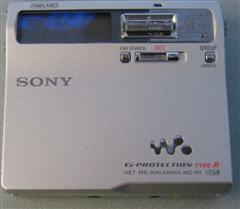
Face shot of the Sony MZ-N1
Photo courtesy of Japan-Direct (www.japan-direct.com)
The MZ-N1: Sony's first NetMD Walkman
In December 2001, Sony released the MZ-N1, the first Sony NetMD walkman (Sharp released their first NetMD model at about the same time, the IM-MT880, which is almost physically identical to the MD-MT770, with the addition of a USB interface). If I had to sum up a description of the MZ-N1 in a sentence, I would call it a face-lifted MZ-R909 with NetMD capabilities. And expectedly so, since the N1's release (Dec 14 in Japan) is only four months separated from the R909's August release. Partly as a result, the N1 by itself (when apart from the computer) is almost identical in functionality to the MZ-R909. Page two of this review will cover details of the MZ-N1 unit itself, while Page three will go over the OpenMG Jukebox software interface. Page four closes out the review with my overall impressions of the MZ-N1.
While I will try to make this review readable and understandable to casual MD users, I will not attempt to answer the most basic questions about the MiniDisc format in general. If you are new to the MD format, and are wondering things like how minidiscs work, or if you don't know what ATRAC is, then you might want to start by doing some reading at www.minidisc.org (newbies will find the newbie FAQs particularly helpful) and T-Station (www.minidisct.com).
Since the N1 is so similar to the R909 (and since I went through painstaking lengths in writing the R909 review just 4 months ago), my review of the unit itself won't be as detailed as normal. However I will still go over the important details and tidbits of this wonderful MD unit. I have also scanned the entire English section of the N1's instruction manual, so if after reading this review you still have any questions about how the unit (or any of its features) works, feel free to browse through the scans - they are linked on the left-hand column of each page of this review. You can also browse through my R909 review, since much of the operation between the R909 and N1 are identical [click here for my Sony MZ-R909 Review (August 2001)]. Most of the snapshots and screenshots in the body of the review are thumbnailed to minimize page-load time. If you wish to view the full-size version of a picture, just click on the thumbnail and the full-size will pop up.
Some of the most significant changes from the R909 are summed up below. While very little has changed in the 4 months between their releases, they are worth noting:
- BEEP options for the MAIN UNIT and REMOTE - The N1 has separate BEEP settings for the main unit and the remote - both are ON by default. Previous Sony units would only BEEP when a button on the remote was pushed, and not beep when a button on the main unit was pushed.
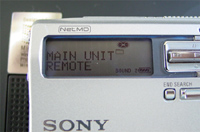
Separate BEEP options for the main unit and remote
- Charging stand will charge battery during use - The USB/charging cradle will charge the internal battery even if the unit is being used! Unfortunately, the cradle will still try to charge a battery that is already full, and there is no way to stop the cradle from charging. While the R909 could not really tell whether the unit was attached to the external battery case or its charging cradle, the N1 now actually flashes the word "CHARGING" on the display when charging in the cradle. If you charge the battery the old fashioned way (ie, plug the adapter into the unit's DC jack and push STOP/CHARGE), then you will still only be able to charge the unit while it is stopped. Charging time is now the same - ~3.5 hours - for either method.
- Group Number display in main LCD - When you are in GROUP mode, the first line will show "GPXX", where XX is the group number, along with the track number. The R909 simply showed the track number, and not the group number. Another improvement in the main unit's LCD is that the text/indicators are now black, instead of blue, which results in improved visibility.

The N1's 3-line text display
- Rocker-Control bar - The R909's circular control pad has been replaced with a "rocker-switch" control bar (which works the same way as the R909's control pad).

The N1's controller/rocker-switch
- Open Slider-Switch - The OPEN push-button has been replaced with a slider switch. This makes sense ergonomically since you often push down on the top of the unit to get it out of the cradle, and if the open switch was still a button, this would cause a headache.

The N1's Open slider-switch
- New Remote Control (Kanji/Hiragana enabled) - The N1 comes with a slimmer, slightly redesigned remote control which has the ability to display the multi-byte (Kanji) layer of disc/track title information. Kanji titles must be entered via the OpenMG Jukebox software, and only works if your OS is set to Japanese. Despite my earlier mis-diagnosis, Kanji titling is possible on the Japanese MZ-N1 if you install the software in Japanese (Kanji titling will not work if you install the software in English).

Kanji display on the new remote
- New Melody timer songs - The 3 available alerts for the N1's melody timer are "Ode To Joy", "Somewhere Over The Rainbow", and "Twinkle Twinkle Little Star". While these simple monophonic melodies are nothing to get too excited about, they are a nice touch nonetheless.
For those wondering about the N1's motor noise, the level of motor noise is about the same as the R909 - only slightly quieter than the R900, but not nearly as quiet as the almost-silent Sharp MT77. I've never used an MT770 or MT880, so I can't comment on the level of motor noise on those two models, but my guess is that they're just as quiet as the MT77.
Improvements made since the R900 generation
Since the N1 was announced less than a month after the R909's release, there are probably a number of users that are not familiar with the improvements that Sony has made since the R900. While these features are not really "new" with the N1 (they were new with the R909), they are fairly significant and worth mentioning:
- Recording Levels are adjustable DURING RECORDING once you are in MANUAL recording mode. You must still pause the recording, enter the menu, and change the RECVOLUME option to MANUAL (and this setting always reverts from MANUAL to AUTO after each recording), but just having the ability to do this is a welcome addition. With creative use of this feature, you can even fade-in and fade-out your recordings.
- Group Function - With the advent of MDLP, keeping track of up to 320 minutes of music (and navigating through on big pool of 40-50 tracks) became a potential chore. The GROUP function allows users to organize groups of songs into separate partitions, or "groups"
(i.e., by artist/album/genre/etc.) The OpenMG Jukebox software now allows you to organize your groups with ease. To learn more about the Group function, please read over page 4 of my R909 review, where all of the Group function details are covered in-depth.
- ATRAC DSP Type-R - Sony's Type-R ATRAC gives twice the signal processing power as previous versions of ATRAC, and specifically improves encoding performance in the higher frequencies. But unless you've got truly golden ears, don't expect to hear much of a difference from ATRAC 4.0 [FYI, only realtime SP recordings use the Type-R codec, and not MDLP recordings or SP recordings done via OpenMG Jukebox transfers].
- 3 line text display on the main unit's LCD - by default displays the track/group number, title, and time simultaneously! The 3 line display gives birth to one of the bigger improvements made by Sony in the last few years...
- Separate L and R level meters - During recording, the 3rd line of the text display acts as the level meter (a smaller, separate meter at the very bottom of the display is used during playback).
- Fully turning jog-dial - A feature absent between the R50 and R909 generations, the same jog dial returns on the N1. The jog dial allows browsing of track titles as well as access to the N1's vast menu system.
- G-Protection - Sony's newest form of anti-shock protection. G-Protection eliminates practically all skipping by minimizing the read recovery time, and without relying solely on a buffer. MD users can finally go jogging with their MD for more than 40 seconds! ^_^
- LP Stamp - The N1 has the option to turn off the LP stamp for MDLP recordings. By default, an "LP:" will automatically be prepended to the title of any track recorded in an LP mode (but this "LP:" will only show up if you try to play the LP track on an older, pre-MDLP unit). This option was available on most Sony MDLP home decks, but it was missing from the R900. If you're heavy with your track titles, turning this option OFF will help you make the most of the 1700~ character-per-disc limit.
- Sound Presets - Two sets of bass/treble settings can be changed from the main unit and the remote (the R900 only allowed the actual settings to be changed from the remote).
- Line Out Mode is now completely sticky - meaning, once you set the AUDIO OUT setting to LINE OUT, it will stay there until you manually change it back to HEADPHONE. Previous models (the R900 and R90/91) would automatically revert back to HEADPHONE if you let the unit power off, which was an extremely big annoyance to folks that used their portable MD primarily with a bookshelf system, since they would have to go back into the options menu and change the setting back to LINE OUT everytime they turned the unit back on.
- END SEARCH is still there, and like the R900 and R909, the N1 will let you automate it by setting the "Rec-Posi" option to "FROM END". If you have GROUP mode turned ON, recording will start from the end of the current group, even if the "Rec-Posi" option is set to "FROM HERE". Pushing END SEARCH in GROUP mode will tell the N1 to start a new group. So if you have GROUP mode ON, you will never have to worry about accidentally overwriting existing material. Perhaps this is the closest we will get to completely eliminating END SEARCH as we know it (?).
"Why Sony... why not Sharp... (or vice-versa)?"
If you're shopping for an MD unit, and you're not sure what name to go with (particularly, Sharp and Sony, as they seem to be the two most popular), the Sony MZ-N1 and Sharp IM-MT880 are direct "rival" units.
The Sharp MT880 has the USB jack on the actual body (the Sony N1 requires you to dock the unit in a USB cradle), and Sharp units tend to have deeper bass to their sound. But the Sharp MT880 does NOT have a text display on the main unit (only on its remote does it have a 2-line display; the MT880's main unit's display only shows track number/time, battery life, and other basic info, but not track/disc title info), while the N1 has a 3-line display on the main unit. Also, the N1 will time-date stamp your realtime recordings, so that you can look back and reference the exact date and time of a recording (useful for interviews and lecture recordings). Sony units also allow you to title/edit tracks during playback, while Sharp units only allow this while the unit is stopped (of course OpenMG Jukebox tilts the titling scene a little bit). On the other hand, Sharp tends to make more of their basic functions available through separate buttons (for things like display, playmode, bass/sound), where as Sony buries even semi-basic functions (like changing SOUND presets) into its complex menu system. Meanwhile, the jog-dial on the R909 and N1 is extremely useful and really makes a huge difference to the usability of the interface... but Sharp units offer synchro-recording for digital and analog/mic sources, while Sony only offers synchro for digital sources, and not analog. Also, when you hit record on a Sharp unit, it starts off in record-pause (convenient for monitoring levels before recording), whereas the Sony requires you to hold down the pause button while you slide the record switch if you want to start in record-pause...
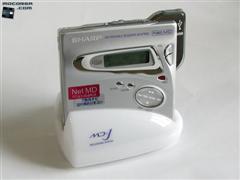
Sharp's rival NetMD model, the IM-MT880
Photo courtesy of Minidisc Korea (www.mdman.net or www.mdcorea.com)
I think you get the idea. I could spit out a million things that are disctinctive/advantageous to one brand or the other (if you've read my R90-831 review, you know), but when it comes down the most basic functions, most MD units pretty much do the same things: they allow for recording of virtually any audio source (provided you know what kind of connections to use) and they allow you to enjoy very high-quality audio recordings on the go in a small portable package.
That said, let's get into the details of this fine MD unit...
Import Warning
If you live outside of Japan and are wondering when the N1 will be available in other countries, the UK release is scheduled for January 2002, while the US release is scheduled for March/April 2002. If you don't want to wait, there are a number of retailers that sell the Japanese model online (I personally recommend Japan-Direct, but there are a number of retailers to choose from). This review (and all of the pictures of the N1 in this review) is of the Japanese model of the Sony MZ-N1.

Check out the thickness of the manual!
Luckily there is an English section in there...
The N1's instruction manual contains a complete English section, and (as you can see from the pictures) all of the body labelings and menu options are in English, so the N1 is fully usable if you don't know any Japanese. The manual for the OpenMG Jukebox software however is completely in Japanese (but you should be able to figure most of it out... if not, I've got the essential details on page 3 of this review). So if you decide to take the plunge and import this fine machine (as some of you will), there are three things to be aware of when importing a Japanese product: Import taxes, Voltage, and Warranty.
• Import taxes are more of a concern in Europe, where no matter who you import from, you're likely to get slapped with a fairly significant duty bill - do some research to find out exactly what percentage (most internet retailers are selling the N1 for somewhere in the $380-$420 range, US Dollars). If you live in the states, imported electronics are subject to customs charges, however, I have not once heard of anyone in the US being charged import taxes on an MD unit. But that doesn't mean that it can't happen, so don't cry foul if you're the first.
• Voltage differences are a source of much confusion for those that have never before imported electronics from another country. The Japanese model of the MZ-N1 comes with a 100V AC adapter, and unless you live in Japan, the AC voltage in your country will be something other than 100 (it is 110-120VAC in North America, and ~220VAC in Europe, OZ, and other parts of Asia). To put it simply, if you use the included 100V adapter in your country, the adapter will supply the wrong voltage to your MD unit. If you live in the US, you might be able to get away with using the Japanese adapter, since the voltage difference is only about 15% (and this is what a lot of users in the US do). However, there is a slight risk of damage (and if you use the 100V adapter in the US to charge the battery, over time your rechargeable battery may wear down prematurely), so if you live in North America, it is strongly recommended that you get a proper 120V AC adapter (output specs are 3V DC, with at least 500mA - Sony adapter model# AC-E30HG meets these specs and are available at most Best Buy locations).
• Warranty is something that some users ignore - and end up paying the price for. Like most portable electronics in Japan, the N1 comes with a 1 year Japanese warranty (assuming your unit was obtained from a proper outlet, and not from the "gray" market). However this warranty really is only for people in Japan, so should you ever have a problem with your unit, you would need a contact with an address in Japan that could send your unit to Sony for you. Some retailers will do this for you (Japan-Direct and a few others), while many just stick you there with the unit, even if it goes defective. Be careful when you are shopping around the internet, and make sure that your back is covered if your unit decides to turn into a $350+ paperweight. Note that even if the retailer that you order from does offer warranty support, you will usually still need to send your unit back to them (in Japan, or wherever they are located), and this process usually has a turnaround time of 3 - 5 weeks. Sound like a long time? It sure beats being stuck with a lemon.
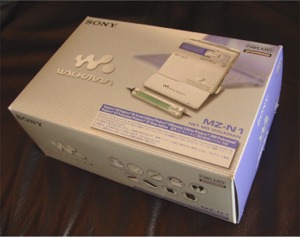
The MZ-N1's Japanese packaging
Please - do your homework before you import anything. I see a lot of people that buy something online from places like Hong Kong or Singapore and then ask, "What am I supposed to do if this thing breaks down?" This is really something you should figure out and research before you buy. Importing electronics really is not something that is difficult to manage (or altogether risky), you just need to be aware of the circumstances.
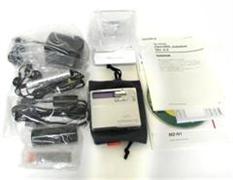
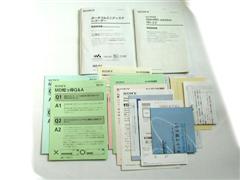
Contents of the N1 on the left (still wrapped), and all of the included documents on the right.
Photos courtesy of Minidisc Korea (www.mdman.net or www.mdcorea.com)
Now it does appear (at least in some cases) that Sony US is capable of being generous when it comes to repairing units that were purchased from another country - Click here to read one user's [positive] experiences with his local Sony service center.
|
[ Next Page ]
|
